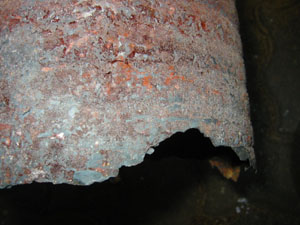
To force the pressurized air onto the charcoal we used a steel pipe whose end we first crimped shut before drilling holes through one of its sides. The charcoal would sit atop the holes and have the air forced directly onto the coals. This also did a reasonable job of preventing ash from building up. When the ash did build up a blast of higher then normal pressure air seemed to help stir up the ash to keep the air channel to the coals open.


The bottom of both the can forming the inner lining of the foundry, and the bucket acting as the outer foundry wall were drilled with holes. The holes let ash out and air in. The inner and outer linings were riveted close enough together to keep out the perlite insulation. The outer jacket came away virtually intact. The inner lining on the other hand just lifted right out of the foundry. It had been completely eaten away by oxidation and literally crumbled when touched.


The inner lining for the foundry literally was eaten away within about 8 melts. My understanding is that this is cause by oxygen that is not burned up in combustion reacting with the heated metal of the lining. I would not recommend a metal inner lining like this unless it was a disposable foundry. We literally got all the parts for this foundry out of the garbage.